Teiz Motorsports “Mojave” Mesh Suit
The Teiz Motorsports Mojave one-piece mesh motorcycle riding suit is comfortable in warm to hot riding conditions.
It is made from 500 denier Cordura and 600 denier mesh with CE-approved armor throughout.
It also incorporates a removable thermal and water-proof liner, all at a very competitive price.
Teiz Motorsports has just celebrated (at the time of this writing) its third anniversary.
The production factory is located in Pakistan while the operations are based in Texas with the shipping warehouse in Illinois.
Teiz offers seven one-piece riding suits and one two-piece riding suit. The two-piece suit is based off a one-piece design.
The Mojave mesh riding suit is a highly upgraded version of the original Teiz Cross Continent one-piece mesh suit (review) reviewed on webBikeWorld n May 2009.
It seems that research and development of the Teiz suits have been mostly driven by rider input and real world evaluations.
Do you really want a 20-something year old trying to design the next motorcycle fashion statement? Doubtful. You want gear designed by riders for riders.
This is not saying the Teiz suits are not stylish. They are indeed…but functionality, protection, comfort and wearability seem to be the paramount concern.
The Teiz Operations Manager, Ghazi Farooq is an avid rider.
Call customer support and most likely you will speak directly to Ghazi. The same holds true for email inquiries. Ghazi seems to be very focused on great customer service and proper communication.
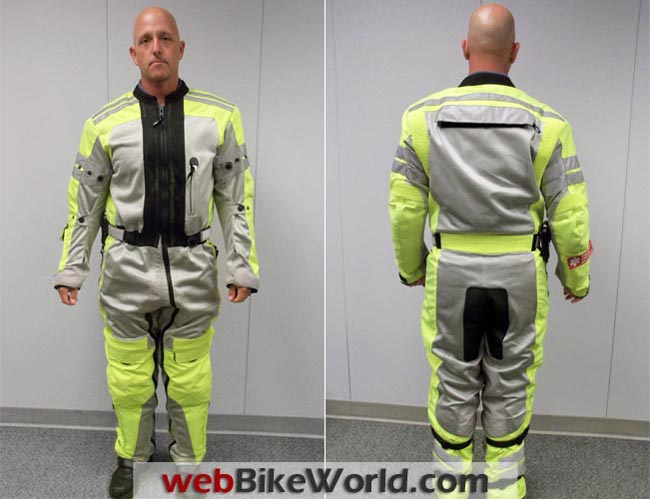
Where to Teiz Mojave Clothing
Check Reviews & Prices on Amazon Check Reviews & Prices On RevZillaAlso Shop for: Motorcycle Jackets, Motorcycle Gloves, Motorcycle Pants
My Riding Gear Quest
I have been wearing the Aerostich Roadcrafter — considered to be the “grandfather” of modern one-piece motorcycle riding suits — for several years.
The Roadcrafter is an amazing, no-frills outfit and bar none one of the best pieces of riding gear I have ever owned. But it does have its limitations.
It very much lacks warm- to hot-weather wearability and comfort, especially for stop-and-go commuter traffic.
Still, if I were to head out on a cross-county trip, I would most likely grab the Roadcrafter outfit without hesitation.
In this rider’s opinion however, in temperatures above 85-90 F, you may as well wear a portable sauna rather than donning the Roadcrafter, as you will be just as uncomfortable.
While I can comfortably wear the Roadcrafter eight to nine months of the year (September through mid-May), the warmer summer months had me clamoring for cooler gear, such as my Fieldsheer two piece mesh jacket and pants.
In a way, I dreaded the summer months, because of the oppressive Eastern North Carolina heat and also having to deal with two-piece riding gear.
I really like the one-piece outfit for its ease of entry and exit and overall wearability, especially as a daily motorcycle commuter. So my quest for a mesh one-piece suit began.
As I discovered, the selection of one-piece mesh riding suits is extremely limited, to say the least. My web searches came up with two readily available solutions that did not break my budget, however: the Olympia Stealth and the Teiz Mojave.
Yes, Cycleport/Motoport offers a mesh Kevlar one-piece suit. But I did have a budget and a $1200+ suit was not in the plans at this time.
I had never heard of Teiz Motorsports but I had seen and heard of Olympia. I found a used (nearly new) Olympia Stealth and tried it on and rode my motorbike a couple days commuting. The suit did flow air nicely but the suit just lacked some dimensions, in my opinion.
Without going into detail, let me just say, I was not overly enthused with the Stealth. Maybe it was the three piece zipper for getting the suit on and off; the Stealth has one zipper for each leg and a crotch to neck torso zipper.
I was used to the Roadcrafter neck-to-foot main zipper on the left side and crotch-to-foot zipper on the right.
The Stealth felt like I was trying to put on a set of work coveralls rather than a motorcycle riding suit. Additionally, the knee armor was not in the proper position for me.
Granted, the Stealth seems to be a high-quality suit with ample protection, but it just did not fit me well enough to own and use daily.
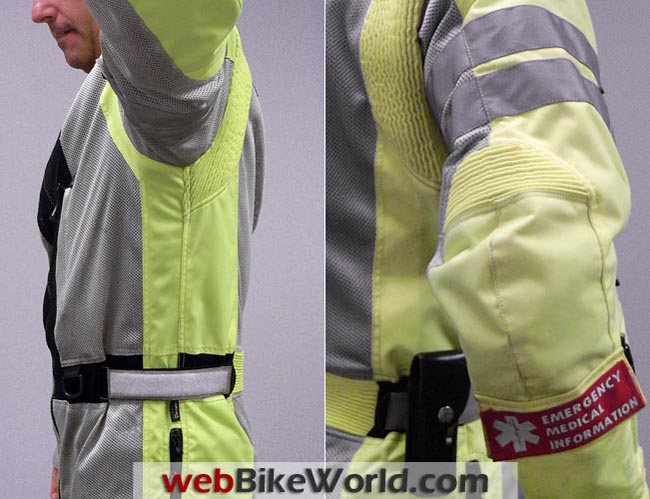
The Teiz Motorsports Mojave Suit
I contacted Teiz Motorsports and they offered to ship a suit to me on a trial basis (once I deposited the cost of the suit via my debt card). I was assured that my card would only get charged if I did not return the suit.
Within a week I had a Teiz “Lombard” suit in hand. The Lombard is one-piece, textile, non-mesh design and it is the most popular-selling suit in the Teiz Motorsports product line, according to the company.
The Lombard in size XL was too big for me, however, so I then tried a Teiz “Commute” suit, a lightweight version of the Lombard. Although I was confident that the quality and construction of the suits was top-notch (as was the included armor), neither of those two were for me.
I was then ready to make a purchase of the Mojave mesh suit, even though I had not physically seen it or tried it on. However, Teiz Motorsports did not offer a Hi-Viz version of the Mojave at that time, only the standard light grey mesh with dark grey textile.
I fully believe in hi-viz gear and was not willing to compromise on this factor (sure, I could wear a hi-viz vest, but that sort of defeated the purpose of mesh).
After a few more emails with Teiz, they announced that the Mojave mesh suit would be available in light grey mesh and hi-viz textile within the month.
I waited about a month and found that the suits were in stock at the warehouse in Illinois and ready for immediate shipment, so I immediately placed an order.
Since the suits are made in Pakistan, U.S. customs often come into play regarding the delivery schedule. Teiz makes a batch of suits in Pakistan and then ships them to the warehouse in Illinois for U.S. distribution, but it is not uncommon to have to wait up to one month for your suit to arrive.
I am not privy to the manufacturing and shipping schedules but I assume if you order at the end of a batch run then you may have to wait for the next batch to get made, shipped and cleared through customs.
If you order at the beginning of a cycle then you will, as I did, receive your suit within 3-5 business days.
These are not hard-and-fast rules, but simply from my experience as more of a rule-of-thumb. Teiz Motorsports can tell you from the get-go how long it will take for your suit to arrive once the order is placed.
Materials
The Mojave suit is made from 500 denier DuPont Cordura and 600 denier “T-Tex” Polyester mesh. I am not sure who manufactures the T-Tex mesh; perhaps it is a Teiz exclusive.
The textile portions of the suit are double-layered at the impact points such as knees, shoulders and elbows. There is double stitching at some seams such as the shoulders and knees.
It appears that most of the double stitching is in the possible impact prone areas and where the textile and mesh mates together.
At the waist, elbow, knee as well as the lower shoulder areas are articulated panels that allow greater freedom of movement.
These panels are becoming more standard on riding gear as they allow better flexibility of the suit and saves wear and tear on the stress points from normal use.
The neck and sleeve cuffs are lined with a type of very soft felt. I find no hot spots when turning my head from side-to-side. The suit is also lined throughout the inside with a typical mesh material as used in most riding jackets.
This allows more air flow and keeps the textile and outer mesh from rubbing on your clothes or skin.
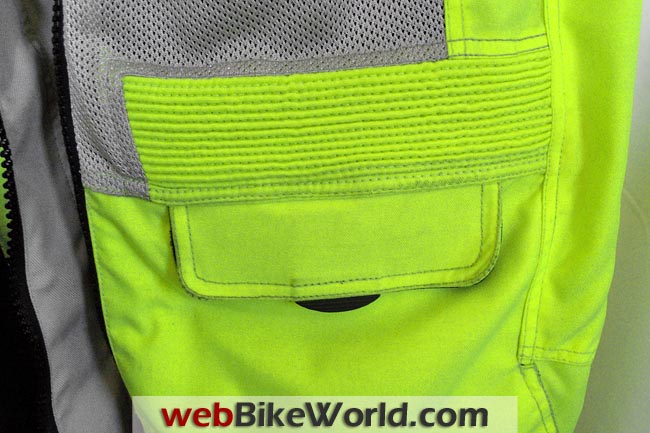
Armor and Padding
CE-approved (claimed) hard shell armor is located in the shoulders, elbows, knees and shin. Yes, you got it…armor on the shins. I do not know of any other riding gear pant (one-piece or two-piece) that offers shin armor.
A nice big portion of armor is also located for the back. The elbow armor also extends to cover nearly all of the forearm area.
The Mojave does not come with hip armor; this is a bit disappointing considering the other armor that does come standard. I was able to retrofit some hip armor from another vendor into my suit.
If you are looking for, what I consider total protection, this may be an option you wish to pursue as well.
The knee armor has an internal pocket which offers an adjustment area. Within the pocket there is a strip of hook-loop material. From outside the suit a hook-loop secured flap covers the adjustment pocket.
You can position the knee armor according to your proportions and then connect the hook-loop and the armor stays in position.
The knee armor seems to be too small for the area it is attempting to protect. The knee armor, and all the other armor, is typical hard shelled CE armor, but I cannot get the knee armor into the proper position.
If I move it so it’s in the correct position while riding then it is not in the correct position went I put my knees on the ground. If I put it in the correct position for ground contact then it is in a very uncomfortable position for riding.
My thought it that all armor should be nearly unnoticeable while riding and then also be in the proper position if a get-off occurs. Armor is virtually useless until you need it. When you need it shouldn’t it be in the proper position?
I have contacted Teiz Motorsports about this matter and they are attempting to offer a solution with other types of knee armor.
The other armor within the suit is free from distractions when riding or standing or walking. In my opinion, if the knee armor was the proper size then the adjustment pocket would work rather nicely.
Unfortunately, I do consider the knee armor to be undersized.
The shin armor does take a bit of getting used to. If you have motocross type boots or boots that are 14″ tall, you may want to remove the shin armor if it makes the lower leg too bulky. Riders using shorter style boots will definitely appreciate the shin armor, however.
If you wish to tuck the suit legs into your boots then the shin armor will have to go. However, I do not think the suit was designed to be worn with the legs tucked in due to the mechanism for adjusting the lower legs….more on that in a bit.
On the inside cuff of each leg is a small section of hook-loop material that attaches the inner mesh lining to the outer portion of the suit. To access the shin armor for removal separate the two cuff sections to reveal a neoprene pocket that securely hold the shin armor in place.
All of the armor is removable to allow the suit for washing in a standard washing machine.
Overall, I’d rate the armor with a B+. No hip armor is a deduction and the odd shaped and undersized knee armor is also a deduction. The back armor that nearly covers the entire back area gain points.
The armor that comes with the suit is more than adequate. If Teiz would add hip armor and beef up the knee armor to the proper size this grade would immediately go up to a solid “A”, in my opinion.
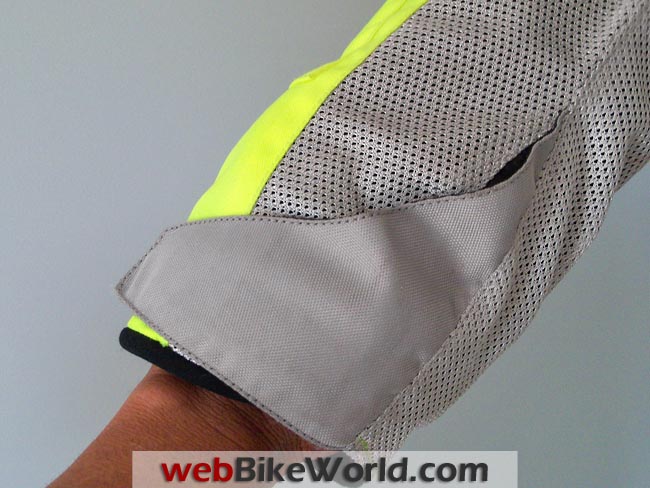
Teiz Mojave Suit Adjustments
The Mojave suit has typical adjusters to size the bicep and forearms to the riders proportions. These two areas have a three snap arrangement.
The arm adjusters are hardly noticeable once adequately adjusted to your proportions and they do keep the elbow armor securely in the proper position.
Waist adjusters are integrated to snug up the torso area and are secured with hook-loop sewn into each strap.
The arm and waist adjuster are what you would find on any typical riding jacket. I secured my Leatherman tool and sheath using one of the waist adjusters; similar to a belt. Grade: A. Thanks for not trying to reinvent the wheel.
Each sleeve cuff has a gusset type adjustment held with hook-loop material.
I find this to be a nice feature that allows adequate adjustment for several types of gloves from heavy gauntlet to short street gloves and also allowing the gauntlet to be worn inside or outside the sleeve.
Cinching the cuffs tight around the wrist doesn’t produce the dreaded bunching of material as the gusseted cuff works as designed.
Depending on the type of glove you use you may also be inclined to set it and forget it on the sleeve cuffs. If you are one that tightens your cuffs when putting on the suit and then completely loosens when you take the suit off the hook-loop material will may begin to fray and or the stitching that holds it to the cuff may start to give, especially after prolonged usage.
The jury is still out on the longevity of the cuff closure mechanism. I generally keep my cuffs at a normal position and do not adjust each time I wear the suit so I assume that I will get many miles from my cuff closure.
If you are the former rider then your mileage may be considerably less. This one item is definitely not a show stopper but something that I think should be mentioned. Grade: B+. I am deducting a few points on the potential failure, in the long run, of the hook-loop and or stitching at the sleeve cuff.
The lower leg area has a unique adjustment mechanism which consists of two nylon straps on each leg with nylon adjustment sliders. It may take a few rides to get these into the proper position.
I found that if you have to tighten these straps much then the lower leg material will gather or bunch up. Riders with tall boots should not have any issue as the lower legs have ample room.
While experimenting with the positioning of the lower leg straps, if I tightened the straps too much then the pant legs would ride up a bit. Conversely, if I loosened them too much then the wind would blow up my leg and make the pants ride up. You will need to take a few rides and find the “happy medium” position for you.
While I like the Mojave leg adjusters much better than a single hook-loop strap located at the very bottom leg cuff as are on most riding pants, the nylon strap and adjuster arrangement does take some getting use to.
However, these seem to be a “set it and forget it” arrangement. You should not have to loosen the straps to doff the suit as the main and leg zippers eliminate the need to do so.
I’ll rate this as a B-. I deducted a few points as with the leg adjusters I was not able to find a way to make the lower legs look “clean” once adjusted to my liking.
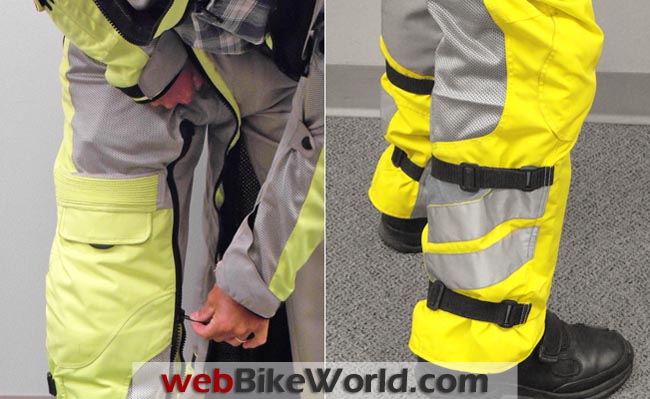
Where to Teiz Mojave Clothing
Check Reviews & Prices on Amazon Check Reviews & Prices On RevZillaAlso Shop for: Motorcycle Jackets, Motorcycle Gloves, Motorcycle Pants
Teiz Mojave Suit: Zippers
YKK zippers are used throughout the Mojave suit. The main zipper is a foot-to-neck, heavy-duty, one-way zipper located on the left side (One way, meaning it can only be started from the foot and then zipped upwards towards the neck).
Once the main zipper is zipped up (closed), the pull tab or slider is located at the neck, as would be with any jacket. The right side zipper runs from the inner leg area just above the knee to the foot. This zipper works in a downward fashion.
Meaning, zip down to close and zip up to open.
The chest pocket has a water resistant zipper which the teeth have a rubber cover of sorts. The hip entry zippers and the back pocket zipper are standard zippers.
Depending on your motorbike and your riding position, the leg zippers may tend to rub against the tank or side fairing. These zippers are not covered with any material to buffer the zipper from coming in contact with the fairing or tank.
After several weeks of riding I have noticed a few swirl scratches on the faux tank fairing of my Honda GL1800 Gold Wing.
This is also the case when I stretch my legs to use the highway pegs as the leg zippers tend to rub one specific spot on the outer fairing. As the leg zippers are on the inner portion of the riders legs the zippers have the great potential to come in contact with painted parts of the bike.
Fortunately, there are aftermarket tank protectors (such as the 3M Scotchcal paint protection film we have reviewed – Editor).
This is one area that I think Teiz should redesign immediately. Adding a small flap of material over the leg zippers would be a quick fix to the rubbing issue without taking away the looks of the suit or restricting air flow.
Notice the photos of the suit’s chest pocket. There is a flap of mesh material covering the zipper. Adopting this feature to the leg zipper is greatly needed.
Functionality of the zippers and YKK zippers throughout the suit get an A+ from me. But the leg zippers that rub the tank get a D. This issue may be the deal-breaker for some riders.
Wearing the Teiz Motorsports Mojave Suit
The main entry zipper on the Teiz Mojave suit is immediately noticeable for the absence of any hook-loop or material flap-over. Why? Well there is no need. This is a mesh suit. It is not a water resistant suit so why have an extra flap on the zippers to keep out the weather?
This makes donning the suit even easier and faster. Plus, no worries on the hook-loop grabbing everything in reach when zipping the main zippers. I can easily put on the suit in 15-20 seconds, from taking the suit off the hanger to fully zip up and ready to ride.
Seat
The Mojave pants have a rubberized material on the seat. I have heard this referred to as the “grippy-butt”, so let me stick with that nomenclature; I guess that describes it as well and any other term.
This material does indeed function as named. While riding, I found myself positioned on the seat without sliding forward as I tend to do on longer rides. When I sit upright, I stay upright.
The rubbery material is fused and double-stitched on to the seat area of the pants and it may offer a bit of water resistance when sitting on a rain soaked saddle, especially after a summertime thunderstorm and the evening commute home. I give this an A+.
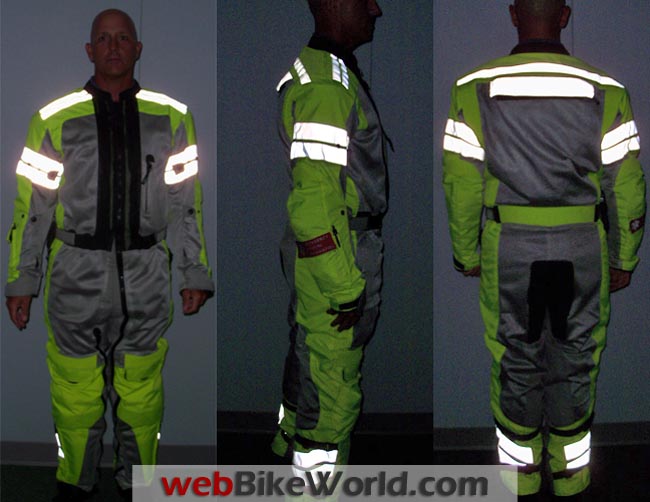
Reflectivity
One thing I have noticed from the three Teiz Motorsports suits that I was able to evaluate is that they all have a tremendous amount of reflective tape placed in strategic areas.
It appears that Teiz may have been inspired by the Rev’It Infinity suit (review) for the reflective points as they are very similar in positioning and size.
The Mojave has two reflective stripes on each bicep, two reflective stripes around each calf, two reflective stripes on the from shoulder/collarbone area, one reflective stripes across the upper back/shoulder area.
A single reflective stripe in the upper back area doubles as the flap for a pocket located on the outer back of the suit.
There is no doubt that you will be visible at night when oncoming lighting shines towards you. The reflective striping is nicely integrated within the suit design. This scores an A++ with me.
Teiz Motorsports Mojave Suit: Pockets and Storage
Maybe I should rename this section to “Pockets: Where Are They?”. The Mojave has only three pockets, of which two are lined with water-resistant material.
One is integrated into the left chest and is a good place to store a cell phone, wallet, etc. This pocket is 7″ x 7″ square, secured with a rubber-covered zipper and it should be fairly water-resistant.
The second pocket is integrated into the back of the suit, as previously mentioned, and it measures 10″ wide by 17″ deep. The back pocket is double secured with a zipper and a hook-loop fold over flap and it should be waterproof.
I guess you could use this to store a rain liner, rain suit, a water bladder (Camel Back style) or something that does not require immediate access, because the suit must be removed to get to the back pocket — or you can have a riding buddy retrieve the contents.
An integrated lower sleeve pocket located on the right arm was nearly missed when I first received the suit. I am not sure if this pocket is offered on the other Teiz designed suits, as I did not notice.
The pocket has a slot to hold a pen/pencil and the overall size should accommodate a small writing pad, or such. I had a custom label made with “Emergency Medical Information” embroidered and attached it to the sleeve pocket flap.
Within the pocket I keep a laminated card with my “In Case of Emergency” (ICE) data, a spare key and a USB thumb drive with some other information (encrypted) in the event that I would need such on the road during an emergency situation. I also slipped in a pen-sized LED flashlight.
A side-hip entry zipper on each hip provides access to street clothes pants without having to remove the suit.
This is a nice feature that is standard on nearly all riding pants these days. These are not pockets, per say, but only access areas.
Adding pockets will reduce the flow, especially if the pockets are lined with water resistant material. It makes sense to me, but it is a tradeoff. Overall, pockets get a B+ from me; the suit is just screaming for another pocket somewhere.
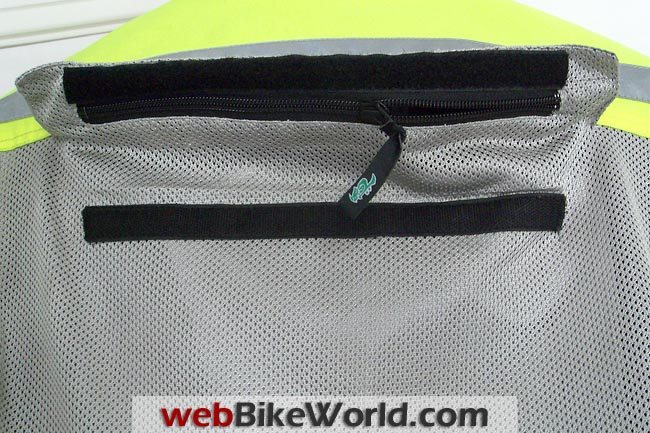
Insulation and Water-Resistant Liners
The Mojave suit comes with a separate zip-in thermal and rain liner. Yes, you read that correct: a mesh suit with a rain and thermal liner.
Most riding apparel now comes with a rain liner so that is not anything new or unique. You may ask yourself “Why in the world would I need a thermal liner for a mesh suit? I bought this suit to wear in warm to hot weather temperatures.”
That was my question also when I received the suit.
I spoke to Teiz on this at length and the thought behind the design is to allow the suit to be a three- or even four-season year-round suit. Also, they mentioned that to make it a four season (cold weather) suit, a layer of electric (heated) gear can be added underneath.
I will admit that for two winter riding seasons several years ago, I did use my mesh pants with heated gear underneath and it worked rather well. The same should hold true with the Mojave.
The rain liner is made of some sort of nylon or vinyl material that will most likely keep you dry. It is a one-piece unit that attaches to the suit at the lower legs, sleeve cuffs and behind the neck with small wrap around snap ties.
The rain liner also zips into the suit at the torso area on each side of the main zipper. This liner has a weather resistant hook-loop flap covering the zippers to keep the elements at bay.
Looking at this liner independently, you can see that, on its own, it is a separate one-piece riding suit, of sorts. Each leg has a zipper for entry-egress; each hip pocket has a water resistant entry zipper that coincides with the zippers on the main suit.
The collar is made of the same nylon-vinyl material with a wrap around hook-loop secured flap for tightness.
I would like to see a softer material in the collar area to protect against chafing. I will surmise that you could also wear the rain liner separately (not within the main suit) as a independent rain suit and stay dry in all but the most torrential down pours.
The thermal liner attaches to the main suit in a very similar method as does the rain liner and is made of a semi-thin Teiz exclusive quilted material. With most riding apparel, you must attach the rain liner in order to get the thermal liner to attach.
Not with the Mojave. You can wear either the thermal or rain liner or both as the attachment points are the same.
The thermal liner also has pass through pockets at each hip to allow easy access to your street clothes pants pockets. This liner does not have leg zippers but are open in these areas to allow donning-doffing to be quite simple.
To get the either liner attached properly and semi-permanently, you should remove the suit and then insert the liner and attach at the specified points mentioned.
If you need a quick way to stay dry or warm, just take off the main suit, slip into the liner(s) and put the main suit back on again without attaching the liners. The main suit will keep the liner(s) in proper position.
For extended wear, take the time to properly attach the liners to the main suit.
The thermal liner, as mentioned above, can be worm separately from the rain liner and will attach to the main suit, however, I have found that for optimum functionality of the thermal liner it should be connected to the rain liner first.
This will also add a second layer if you get caught in cool and especially cool and wet conditions.
Where to Teiz Mojave Clothing
Check Reviews & Prices on Amazon Check Reviews & Prices On RevZillaAlso Shop for: Motorcycle Jackets, Motorcycle Gloves, Motorcycle Pants
Ventilation and Air Flow
As you can see from the photos of the Mojave the suit is virtually 50-55% mesh material versus the solid fabric Cordura. The mesh is located on the suit as to catch the most air flow when riding, while the Cordura is located to protect the rider in the event of a get-off.
I ride behind a full-fairing Honda Gold Wing and can still get great air flow using the windshield vent and Baker Air-Wings. Owners of bikes without a fairing will have even greater benefits and optimal air flow.
Are you going to wear this suit in 100F weather and stay cool in stop and go traffic? Short answer: No!. When it is hot outside, any gear or no gear at all, you will be hot.
As compared to my trusty Aerostich Roadcrafter one-piece, yes the Mojave does flow quite a bit more air onto my legs, arms and torso. Do I stay cooler? That should be the question asked by any potential buyer of the Mojave — not how much air does it flow.
Recently I performed an extreme heat test during two weekends long, nearly Iron Butt rides of 900 miles in the hot and humid temperatures of the Southeast U.S.A. One weekend I wore the Mojave and a couple weekends later I wore the Roadcrafter.
The temperature and humidity were nearly the same (within a couple degrees of each other).
Without going into all the details, let’s just say, I was comparing apples to apples in the riding conditions and using the same bike and even some of the same roads. Which suit does better in the heat?
There is no quick and dirty answer that I can offer.
I was equally as miserable in either suit when stopped in traffic or at a stop for any extended time. I was also equally hot when stopped a few minutes getting fuel and rest room breaks. Again, hot is hot!
My bike has a rider backrest. When riding in extreme heat for hours on end, I usually get very hot on my back and upper torso area.
As I have a back protector pad for my Roadcrafter and the Mojave comes standard with a back protector, my back does not get enough air flow. I can lean forward a few inches as to create a space between my back and the back pad.
With the mesh of the Mojave my back area cools down quite rapidly as where the Roadcrafter takes several minutes and then only when I open my arm to let the underarm pit vent add to the air flow. Winner on this area: Mojave.
However, the mesh of the Mojave also allows for the engine heat to come directly onto my legs and lower torso area. The thickness of the Roadcrafter actually keeps the engine heat at bay. I stay cooler with the Roadcrafter in this aspect. Winner on this area: Roadcrafter.
Overall, I will give an ever so slight edge to the Roadcrafter. One caveat: the comfort of the rider while riding in extreme heat relies heavily on the undergarments worn and the amount of fluid taken in by the rider while traveling.
Wicking type shirts, leggings and the like are catamount to staying fairly comfortable in hot weather riding regardless of the riding gear worn.
Well, what about daily commutes?
Which suit will keep me comfortable in my daily 15-60 minute ride to work and back home? Again, this is very subjective. I also have conducted a month long evaluation between the Mojave and Roadcrafter wearing my typical business casual attire.
Quick answer; I am equally hot and miserable in either suit. Both are hot when the weather is hot.
If you do any errands during lunch time or after work the slight edge goes to the Mojave. I can keep the Mojave on when doing some quick errands where I am off and on the bike, running into a store for a few minutes, back on the bike, etc.
The Roadcrafter is just too much of a beast to walk around in 100F heat. I will take the few seconds to doff the Roadcrafter and leave it on the bike.
For daily commutes you may tend to gravitate towards the Mojave, especially if you live in a hot climate that has constant weather. In the southeastern U.S.A., our summertime weather changes frequently.
The Mojave is mesh and unless you just like getting wet you will have to don some rain gear or use the rain liner that comes with the suit to stay dry. The Roadcrafter is virtually waterproof, especially if you have the newer style zippers. No need to stop to put on rain gear. Just keep riding.
Your experience may vary immensely in this area and each rider is different in their opinions on which is best. The end all to get all answer…it is a trade off. If you are only dealing with daily commutes in hot weather and no rain then the Mojave is a good choice.
Prices and Colors
According to the Teiz website, the Mojave mesh suit is available in several color combinations. The standard Light Grey/Dark Grey color combination cost $349.00 while others are $399.00. There’s an additional $25.00 flat fee for shipping on each suit.
Needless to say, the price of the Mojave is very competitive for a full textile or mesh one- or two-piece riding suit.
Warranty
Teiz offers a limited lifetime warranty. There is some more legal mumbo-jumbo on the Teiz site that you may wish to read to get all the specifics, but basically if there is a defect in the materials or workmanship, then Teiz will repair or replace the suit.
And now for the unexpected: Teiz offers a crash replacement. You get a suit replacement if you are wearing the suit and have a motorbike crash and damage the suit.
There are a few hoops that you have to jump through but nothing that is too far-fetched. First you must register your new suit with Teiz.
Second, you must complete an owner’s review of the suit and take five photos of you wearing the suit or post a two minute video within 30 days of taking ownership of the suit.
Finally, a copy of the police report and the suit must be sent to Teiz and you will get a new suit.
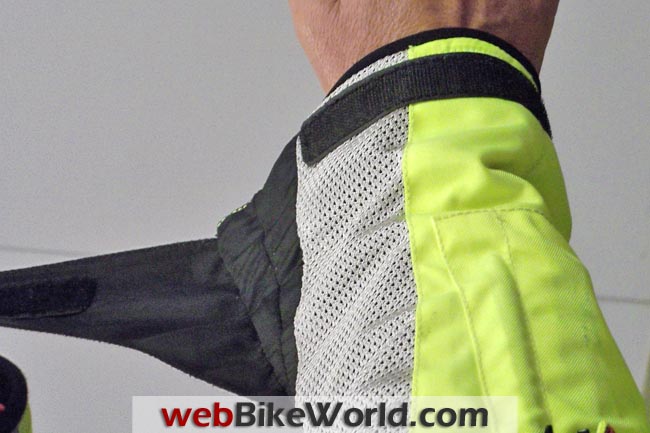
Customization and Sizing
I was fortunate to be able to wear a standard size Large Mojave suit. If you need a custom sized suit then Teiz Motorsports will build it for you (there is an extra fee for this service).
According to the web site and customer feedback, the turn-around time on a custom made suit is about two months.
There is a flat fee of $150.00 to re-vamp the entire suit if needed. However, if you only need the legs made shorter then the same fee applies. I guess if you have an odd shape then a custom made suit may be the ticket.
One nice point is that the Mojave is offered in 11 standard sizes ranging from Small to 4XL and even some tall sizes. If you are uncertain on the size then contact Teiz and ask if you can get a trial suit to try on for size as I did.
Conclusion
The Teiz Mojave mesh one-piece riding suit is a great value for the price, offering more than adequate protection and tremendous ventilation and air flow.
The suit is extremely quick to put on and take off while wearing street clothes and is a near perfect riding suit for commuters or day trips.
The lack of storage pockets is a minor drawback from being considers a true long-distance touring suit, but if you can design your own carry-all pouch as I did, the lack of built in pockets is a minor inconvenience.
The standard rain and thermal liners should prove the Mojave to be a nearly year-round suit for most weather conditions.
The quality of construction, use of materials and thoughtful design make the Mojave a great one-piece suit for any rider.
| wBW Review: Teiz Motorsports Mojave One-Piece Mesh Suit | |
|---|---|
| Manufacturer: Teiz Motorsports | List Price: $349.00 to $399.99 |
| Colors: Variety. | Made In: Pakistan |
| Sizes: S to 4XL, Talls and/or custom sizes. | Review Date: August 2012 |
Where to Teiz Mojave Clothing
Check Reviews & Prices on Amazon Check Reviews & Prices On RevZillaAlso Shop for: Motorcycle Jackets, Motorcycle Gloves, Motorcycle Pants
Owner Comments and Feedback
See details on submitting comments.
From “T.G.” (September 2012): “Just had to laugh out loud seeing the atrocious fit from this “custom” one piece suit. I had a years long search to find a pair of riding pants that fit me with out the baggy caboose look. This one has a baggy cow pusher look. I showed my wife these pants and she laughed and said it was a clown suit.
I’m beginning to think Motoport is the gold standard of riding clothes, especially the pants. With them yes you do pay the big bucks and drink the Motoport Kool Aid and promise to become a fanboy but I think it’s warranted when you get back a pair of pants, especially the Street Kevlar jeans that fit perfectly out of the shipping box you get.
Yes again they are expensive but then again is buying a suit like this Teiz, plus a pair of Tourmaster pants, Firstgear pants, Fieldsheer pants and all don’t fit. Heck just return shipping is expensive with all the trials. Bottom line here is the Motoport (perhaps Aerostitch but were taking mesh here, not textile with vents) have properly fitting knee armor.
The Street Jeans are sleek and sexy and the armor fits on the knees and shins. I can wear them under or over boots with no issues. The knee armor is in the right spot because I marked where it was supposed to go and it ended up there. I’m thinking that one saved knee cap is worth the extra 400 bucks to me.
I personally could not walk around in the Teiz suit, because even at over 60 I’m vain enough to not want to laugh at myself. I think for high viz that black with neon accents provides a better contrast especially with a white helmet. And Black bikes don’t help either.
The legs of this “custom” suit also are way too baggy for my tastes. So in mesh one piece suits you don’t have much of a choice but in mesh jacket and pants you do have Motoport and now some choices in Rev’it.
webBikeWorld is a valuable tool for learning about gear you would never hear about. I have also found the Dainese Knee V Guards to be very worthwhile for providing protection to knee to shin when wearing Kevlar jeans where there is zero armor. This armor is very comfortable to wear and stays in place well and ventilates great also.
They are a bit pricey at 70 bucks but worth the peace of mind to me. I just can’t cozy up to Bohn Armor compared to this Dainese armor that does not have the body stocking.”
Editor’s Note: Note: As the author stated, this is NOT a custom made suit. It is off-the-rack.
In any case, the fit of any custom clothing is dependent upon the measurements provided to the manufacturer. It’s possible the owner wanted a roomier fit or that incorrect measurements were provided or that he was wearing bulky clothes underneath when the measurements were taken.
I had this happen to me in the opposite direction in my GiMoto leather one-piece custom suit review. I followed the instructions (I thought) but ended up providing incorrect dimensions to the manufacturer and the suit was too tight for me, as you can see in the photos in the review.
Plus, I wouldn’t be surprised if some error crept in from translating inches to metric… Anyway, it might not be Teiz’s fault; in fact, the Teiz Navigator outfit (review) that Chris B. reviewed fits him correctly and he wears it all the time.
From the Author: “My off-the-rack size large fits me fine for my purposes and daily commutes and touring. Does the Mojave suit have some limitations? Yes. Is it better than my Aerostich Roadcrafter? Nope. No Way!
I still wear my Roadcrafter more than the Mojave, even in warm weather. Just because I hate having to stop and put on rain gear for the daily thunderstorms we get in eastern North Carolina.
The Teiz Mojave it is one of the very few affordable one piece mesh suits on the market that riders could wear day in and day out with great comfort, functionality and protection.
To each his own in the area of riding gear fit. Personally, I don’t want some hip-hugging, junk grabbing, form-fitting garment that I have to struggle with day in and day out to put on and take off. Easy on and easy off is my choice.
From “W.B.” (August 2012): “In the article, it is mentioned that “I do not know of any other riding gear pant (one-piece or two-piece) that offers shin armor.”
Motoport pants have shin armor. Motoport also has chest and thigh armor, in addition to the other usual places, and covers more area with armor than most gear.”
From “T.G.” (August 2012): “Awesome that you guys are reviewing affordable riding wear instead of the trendy high dollar imported leather stuff I typically see and will never own. I really like how this suit is a fast in and out, talk about a big advantage compared to putting on a set of typical riding pants and then doing the dance to get your actual pants down flat, then put on the jacket and attempt to zipper the two together.
I love my mesh jacket and will be really looking at buying one of these suits for summer riding. Here in Michigan we have spent most of the summer in 90-100 degree temperatures and a mesh suit is what I need.
How quickly can you zip in the rain liner, or would it be easier to simply grab a standard rain jacket and pants out of the panniers and put it over the mesh?”
Response From J.H.: I guess “quick” is a relative term. Personally I do not like or use the internal liners that came with the Mojave. I choose to don a Frogg Toggs rain suit.
Without getting completely side-tracked on the difference of opinion on internal vs. external rain liners/suits, I will just stick to the question at hand. As with any internal liner, the suit has to come off the rider to properly attach the internal liner to the suit. Lay the suit down on the floor or ground and insert the liner. Afterwards the connection points that hold the liner to the suit have to attach. It may take 4-5 minutes from start to finish getting the liner(s) installed as designed.
Conversely, the rider may choose to just remove the suit, step into the liner and put the suit back on without attaching the liner to the suit. This method is obviously much quicker that the former and almost as quick as donning external two-piece rain gear.
Choosing the latter method, the rider could have the liner in place within a minute or so. Any rider familiar with riding gear and internal liners would understand the pros and cons on either the internal or external rain liners.
My personal opinion is to use an external rain suit as to save the Mojave from getting wet during a rain shower. True, an external liner should keep the rider as dry as an internal liner, but then you have to contend with a soggy suit once the rain stops and you remove the internal liner. I have also never found an internal rain liner that kept me as dry as an external rain suit.
From “E.Y.” (August 2012): “I suppose the 800 lb. elephant in the room is “What the (heck) is going on with the area below the belt?” on those pants. Baggy is what I’d charitably call it. I get that Teiz is trying to make a go of affordable clothing, but I’d call the fit pretty bad. Just my two cents.”

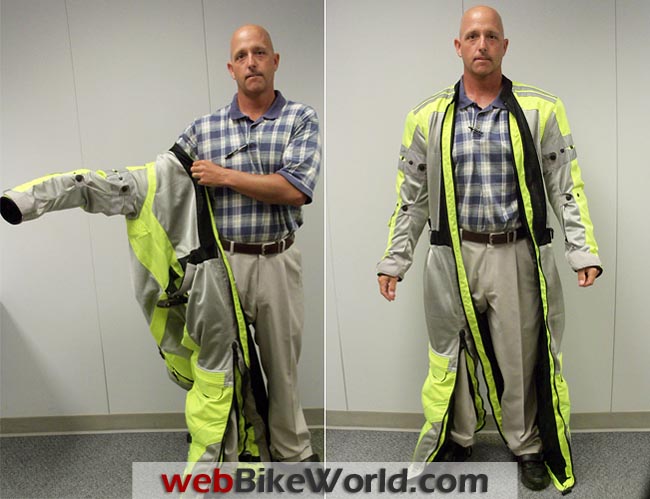


No Comment